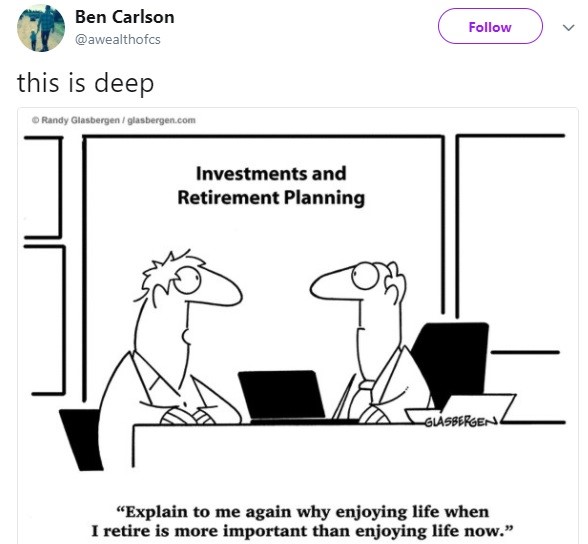Ben Carlson Tweeted out the following;

I replied that “if you can live happily below your means then you don’t have to favor one over the other and probably avoid being 81, very fit and out of money.”
In a related note, Tony Isola from Ritholtz Wealth Management had a blog post pointing out that the 4% rule maybe too conservative for how few scenarios result in running out of money and “the retiree finishes with more-than-double their starting wealth in a whopping 2/3rds of the scenarios” run in a Monte Carlo Simulator.
I believe it is crucial to understand how the 4% rule works before you can make an informed decision about what sort of spending profile to take on if you end up living in some part off of your portfolio. The very short version, of course, is that a 4% withdrawal rate indexed to inflation is widely accepted as having a favorable outcome more than 90% of the time. My tweak on it, to make it simpler is to forget about the inflation as the tendency of the portfolio will be to generally rise in value and to think about 1% per calendar quarter.
The various simulations don’t take into account unpredictable, unplannable events that come along in everyone’s life. I write about these things frequently to include smaller things like vet bills, new tires and other roughly $1000 items (that’d be a bit much for tires) that seem to come along every month. There can be larger household items like a new roof or rewiring a house; what if the transmission goes out on your car? A little more serious; a $50,000 expense for any grown children or a medical issue for you that is not covered. This could be something positive too. What about some sort of $10,000, once in a lifetime experience that ties in with something you have always wanted to do? This idea is connected with Isola’s point.
It is not clear that Isola is saying to have a more expensive regular, monthly lifestyle but I would disagree the idea of planning for 6% plus then adding one-off expenses or events on top of that. It’s much easier to not take a big trip this year than to get out of having two $700 car payments.







